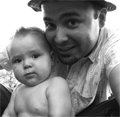
I've commented about the suburbanization of America before, but I don't seem to have the literary smarts (nor the patience!) to write something extensively long. These posts usually begin, and end, after the third line is written.
The good people over at A Daily Dose of Architecture have made my job easier, seeing as I'm hitting (yet again) my delete button and trashing (yet another) post. I'm just linking straight to their site instead...
Sue me, I'm tired.
John Hill, blogtender extraordinaire, serves up an excellent review of the essays compiled in The Suburbanization of New York?, a new book by Jerilou and Kingsley Hammett.
This style of suburbanization is uniquely different from the suburbanization I usually rant about.
For anyone familiar with Anthony Bourdain, you're well aware of the tragedy afoot. It's the plasticizing of iconic America - from the loft converts that jack up the rents of inner-city neighborhoods, to the Bubba Gumpish restaurants that squat in Times Square. We've turned into a culture that franchises the unique, and just like Bourdain, it frustrates me so.
I'm looking forward to checking it out. Read Hill's review HERE or buy the book directly from his site HERE.
On a sidenote...
...if you are, in fact, Anthony Bourdain and just happened to stumble on to this blog by googling your own name (would AB even google?): one day, before I die, I will drink a whiskey/rocks with you. We will complain about the bad for hours on end. Nothing fancy...just a cocktail > in dirty glassware > garnished with sarcasm > served at a place of ill repute > enveloped in smoke > with Anthony Bourdain. I will then die happy.
The good people over at A Daily Dose of Architecture have made my job easier, seeing as I'm hitting (yet again) my delete button and trashing (yet another) post. I'm just linking straight to their site instead...
Sue me, I'm tired.
John Hill, blogtender extraordinaire, serves up an excellent review of the essays compiled in The Suburbanization of New York?, a new book by Jerilou and Kingsley Hammett.
This style of suburbanization is uniquely different from the suburbanization I usually rant about.
For anyone familiar with Anthony Bourdain, you're well aware of the tragedy afoot. It's the plasticizing of iconic America - from the loft converts that jack up the rents of inner-city neighborhoods, to the Bubba Gumpish restaurants that squat in Times Square. We've turned into a culture that franchises the unique, and just like Bourdain, it frustrates me so.
I'm looking forward to checking it out. Read Hill's review HERE or buy the book directly from his site HERE.
On a sidenote...
...if you are, in fact, Anthony Bourdain and just happened to stumble on to this blog by googling your own name (would AB even google?): one day, before I die, I will drink a whiskey/rocks with you. We will complain about the bad for hours on end. Nothing fancy...just a cocktail > in dirty glassware > garnished with sarcasm > served at a place of ill repute > enveloped in smoke > with Anthony Bourdain. I will then die happy.



 From
From 

 Think the article is a good read?
Think the article is a good read? 
 Bus manufacturer extraordinaire
Bus manufacturer extraordinaire 


 As much his idea, at the scale in which it is presented, scares the living Beegees out of me, others continue to
As much his idea, at the scale in which it is presented, scares the living Beegees out of me, others continue to 
